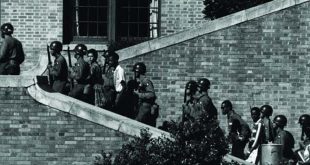THE CRIMES OF THE TIMES
 The New York Times, nicknamed “The Gray Lady”, is America’s newspaper of record publishing “all the news that’s fit to print” since 1896. For those of you familiar with only the International Edition, the hard copy local paper is made up of number of distinct sections: International, National, Metropolitan etc. The Arts Section covering art in all its manifestations is a prominent daily feature.
The New York Times, nicknamed “The Gray Lady”, is America’s newspaper of record publishing “all the news that’s fit to print” since 1896. For those of you familiar with only the International Edition, the hard copy local paper is made up of number of distinct sections: International, National, Metropolitan etc. The Arts Section covering art in all its manifestations is a prominent daily feature.
The Times shuns reporting on crime, sex and scandal leaving those lurid stories to the yellow press, the tabloids, Rupert Murdoch’s New York Post and the Daily News. If report crime it must, as in the case of financial high crimes and misdemeanors, political scandal or a kidnapping/murder that has received national attention, The Times does so in a markedly subdued fashion, “Just the facts, Ma’am” as Sergeant Joe Friday put it in the TV police series Dragnet [1951-1959].
For the past year the Times has been forced to feature art crime on its front page and the front pages of the Arts Section. It has had no choice. It seems that the art world has become mired in crime, a worldwide crime wave that sees no end in sight. The financial stakes that are in play in the art world are high and getting higher and the crimes they generate are as venal, tawdry, downright brutal as any perpetrated by the Mafia.
You would think ballet, the most refined of the dance arts, to be as pure as the white tutus that ballerinas sport in Tchaikovsky’s Swan Lake; yet the Times reports Moscow’s Bolshoi Ballet to be a criminal venue. It seems that extortion, shake downs and bribes are common at the Bolshoi. A young dancer who in 2012 was the first American to join the company was asked to pay $10,000 to land a solo role. Refusing to pay the bribe she resigned. This December a Bolshoi Ballet soloist was sentenced to six years in a penal colony for arranging and paying for an acid attack on the theater’s artistic director. The attack which nearly blinded the director was in retribution and revenge for financially motivated denials of key roles to the dancer and his common-law wife. The Godfather’s Corleone Mafia family would feel right at home playing the Bolshoi.
China’s art and auction market has surpassed America’s, $8.9 billion to America’s $8.1 billion in 2012 warranting a Times’ front page three part exposé starting last October. The exposé rounds up all the usual suspects, the fakers and forgers, and sheds light on a unique Chinese criminal variation of bribery: “yahui” or “elegant bribery”.
The booming Chinese economy has businessmen and companies scrambling for lucrative state financed public works contracts and real estate developments all dependent on senior government officials’ approvals and zoning variances often secured by a culture of gifts and bribes.
The Times documented how elegant bribery works. A businessman purchases a worthless forgery or an art item of little value and gives them as a gifts to a corrupt official with a strong suggestion that they be put up for auction. At auction the businessman and his cronies bid outlandishly for the fake and the resulting sale is the currency for the bribe. The beauty part is should “the scheme be discovered, the minimal value of the fake would mean a lesser punishment”. The Times cites the case of Chongqing City’s deputy police chief as illustration. A search of the policeman’s residence yielded not only $3 million in cash but an expensive art collection which included “more than 100 works, including fine ivory sculptures…a Buddha head carved from stone…calligraphy scrolls [and] a painting attributed to Zhang Daqian…” The cop had turned the bribes into a bona fide art collection, a crime for which he was summarily executed.
In 2013 China kept making the news. Sotheby’s, the New York auction house that had expanded to Shanghai, put up at auction a scroll purportedly by the Song Dynasty poet and calligrapher Su Shi [1037-1101]. It had but nine characters and a pre sale estimate of $500,000. It sold for $8.2 million “[b]ut just months before it was to go on display at Mr. Liu’s private museum in Shanghai, three art historians declared the work a forgery”, not even an original work but produced by a 19th century method of “copying and retracing art works”. Sotheby’s disputes the finding of forgery but an investigation is ongoing.
Even Romania made the front pages. In 2012 in a daring heist of “exceptional skill” seven paintings worth “hundreds of millions of euros”, among them Monet’s “Waterloo Bridge, London” and “Charing Cross Bridge, London” and Gauguin’s “Femme devant un fenêtre ouverte”, were stolen from Rotterdam’s Kunsthal Museum. In July, 2013 the thieves, all Romanian nationals, were arrested and put on trial. But prior to trial the owner of the stolen artworks, the publicity shy Triton Foundation registered in the secretive tax haven of the Netherland Antilles accepted only $24 million dollars paid into a Swiss bank account in full satisfaction for the loss. Three of the thieves plead guilty and the fate of the stolen works, possibly burned by the gang leader’s mother, will be the subject of another front page Times story.
“Bees do it”, thugs do it, even billionaires do it, so let’s do it, let’s do the crime, to paraphrase Cole Porter. On Madison Avenue in the Carlyle Hotel, where Jack Kennedy had his assignations and Bobby Short played the piano for high society, is the Nahmad Gallery, owned by a Lebanese billionaire “perhaps the single biggest buying force in fine art”. In April, 2013 Hillel Nahmad, the scion of this $3 billion art empire [the Gallery had just bought Picasso’s “Mousquetaire à la Pipe” (1969) for $30.9 million] was charged with racketeering, racketeering conspiracy, gambling, money laundering, conspiracy and other crimes along with “33 reputed members and associates of two related Russian-American organized crime enterprises”. He pleaded guilty to a single charge of operating a gambling business using the Gallery as a front, forfeiting $6.4 million and Raoul Dufy’s “Carnaval à Nice”; he is presently awaiting sentencing.
The story that has dominated Times reporting over the past year has been the death by greed of Knoedler & Company, once New York’s oldest preeminent art gallery, until recently housed in a $50 million Italianate Palazzo on East 71st Street next door to Fifth Avenue’s famed Frick Collection. Hundreds of newspaper articles have been written about the forgeries that led to Knoedler’s demise but to summarize: a creative con artist Jose Carlos Bergantiños and his girlfriend Glarifa Rosales either duped Ann Freedman, Knoedler’s President, a formidable force in the art world, or with her knowing participation [the jury is still out on that issue] in selling $80 million dollars in forged art purportedly by Robert Motherwell, Mark Rothko, Jackson Pollock among others, when in fact they were manufactured by Pei-Shen Qian an unknown Chinese artist living in squalor in Queens, New York for a couple of hundred dollars each. Every week brings another Times article reporting of yet another disgruntled art collector suing Knoedler.
On January 1, 2014 the Time’s The Arts section reported that the Springfield [Massachusetts] D’Amour Museum will host an upcoming exhibit “Intent to Deceive” a collection of notable fakes and forgeries including “The Head of Christ” from Rotterdam’s Van Beuningen Museum, “The Girl with the Blue Bow” from the Hyde Collection and “The Procuress” from the Courtland Gallery in London all once attributed to Vermeer that had deceived experts but actually are forgeries by Han van Meegeren. The exhibit was prompted by the Times art critic Blake Gopnik’s controversial essay “In Praise of Art Forgeries” and the debate that ensued. It seems that museums and art critics are catching up with the criminal reality of today’s art world.
Deyan Ranko Brashich, an attorney and Op Ed columnist writes from New York and is a contributing writer. A collection of essays “Letters from America” has just been published in June, 2013. His contact and blog “Contrary Views” is at www.deyanbrashich.com.
 Печат – Лист слободне Србије Политички недељник, актуелна политичка дешавања, друштво, свет, култура.
Печат – Лист слободне Србије Политички недељник, актуелна политичка дешавања, друштво, свет, култура.






